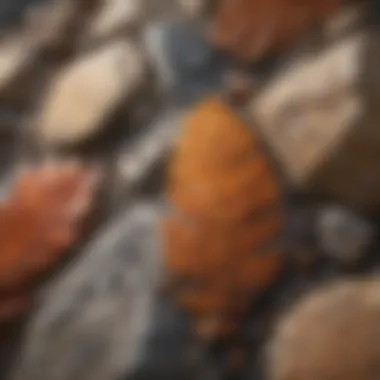Exploring the Intricacies of Foliation in Geological Formations


Rock and Fossil Identification
In the realm of geology, the identification of rocks and fossils serves as a fundamental pillar in understanding the Earth's ancient past. Various types of rocks and fossils hold vital clues to geological processes and environmental conditions throughout history. When embarking on the journey of rock and fossil identification, it is imperative to keenly observe the specific characteristics that distinguish one type from another. These characteristics could encompass color, texture, mineral composition, and structural features that provide insights into the formation and history of the specimen. Utilizing tools such as magnifying lenses, hardness scales, and chemical tests further aid in the meticulous identification process, enabling collectors to delve deeper into the geological narrative encapsulated within each rock or fossil.
Geological Insights
As we unravel the intricacies of foliation in geology, we delve into the profound insights it offers into the Earth's dynamic history. Geological formations and processes manifest through the phenomenon of foliation, reflecting the geological forces that have shaped the planet over billions of years. By studying the distribution of foliated rocks in different geological settings, geologists can decipher the tectonic events, metamorphic processes, and environmental conditions that have impacted the Earth's crust. Furthermore, exploring the historical significance of foliated rocks unveils a tapestry of geological events that have sculpted landscapes and influenced evolutionary pathways. Notable discoveries in the field of foliation provide vivid snapshots of past geological epochs, showcasing the relentless transformations that have defined Earth's geological evolution.
Introduction to Foliation
In the vast landscape of geology, the concept of foliation stands as a fundamental principle that unravels the intricate layers of the Earth's crust. This section serves as a gateway to understanding the multifaceted nature of foliation and its pivotal role in shaping geological landscapes. Delving into the depths of foliation offers a profound insight into the complex patterns and structures that underlie the surface of our planet. Through this exploration, readers will embark on a journey to uncover the importance and nuances of foliation, setting the stage for a comprehensive discourse on this geological phenomenon.
Defining Foliation
The basic definition of foliation
At the core of geology lies the essence of foliation, a defining feature that denotes the alignment of mineral grains in rocks. This alignment gives rise to the characteristic planar structures observed in various rock formations, shedding light on the geological processes that have shaped them. The basic definition of foliation encapsulates this critical aspect of rock morphology, offering invaluable insights into the geological history embedded within these intricate patterns. Understanding the basic definition of foliation is essential for grasping the broader context of rock formation and metamorphic processes, making it a cornerstone of geological studies.
Importance of foliation in geology
The significance of foliation in geology cannot be overstated, as it serves as a key indicator of past tectonic events and the conditions under which rocks have undergone metamorphism. By deciphering the implications of foliation, geologists can unravel the intricate story of geological evolution etched in rock structures. The importance of foliation extends beyond mere visual appeal, as it provides a critical framework for interpreting the dynamic nature of Earth's crust. Acknowledging the role of foliation in geology opens doors to a deeper understanding of Earth's history and the forces that have shaped its geological features.
Historical Perspectives
Early observations of foliation
The roots of foliation can be traced back to early observations made by geologists exploring rock formations. These initial insights laid the foundation for understanding the structural characteristics of rocks and the significance of aligned mineral grains in determining foliation. The early observations of foliation paved the way for subsequent advancements in geological research, sparking curiosity about the underlying mechanisms driving the formation of these distinct patterns. Delving into the early observations of foliation offers a glimpse into the origins of modern geology and the evolution of scientific thought surrounding rock structures.
Evolution of foliation theories
Over time, the evolution of foliation theories has mirrored the progression of geological knowledge, with scientists developing intricate models to explain the formation and significance of foliation. From early speculations to nuanced theories supported by empirical evidence, the evolution of foliation theories reflects the dynamic nature of geological inquiry. By exploring the evolution of these theories, geologists gain a deeper appreciation for the complexities of foliation and the continuous refinement of geological concepts. Tracing the path of foliation theories unveils a rich tapestry of scientific discourse that continues to shape our understanding of the Earth's geological processes.


Tectonic Processes
Subduction-related foliation
Contribution to Geological Understanding
Exploring subduction-related foliation uncovers essential insights into the role of tectonic processes in shaping the Earth's crust. Subduction zones, where one tectonic plate is forced beneath another, create intense pressures and temperatures that contribute to the development of distinctive foliation patterns. By studying subduction-related foliation, geologists gain a deeper understanding of plate tectonics and their impact on geological features.
Key Characteristics
The key characteristic of subduction-related foliation lies in its association with high-pressure metamorphism, resulting in the formation of foliated rocks with unique mineral assemblages. These distinctive patterns aid geologists in identifying the tectonic history of a region and reconstructing past geological events. Recognizing the key characteristics of subduction-related foliation enhances our appreciation of the dynamic processes shaping the Earth's lithosphere.
Collision-induced foliation
Relevance in Tectonic Settings
Investigating collision-induced foliation provides valuable insights into the effects of tectonic collisions on rock deformation. When tectonic plates collide, immense pressures and shear forces lead to the development of foliated textures in rocks. Understanding the mechanisms behind collision-induced foliation deepens our knowledge of mountain-building processes and the formation of major geological structures.
Key Features
The key feature of collision-induced foliation is its association with compressional tectonics, where rocks experience intense deformation along thrust faults and shear zones. This unique feature produces pronounced foliation planes aligned perpendicular to the direction of stress, highlighting the complex interplay between tectonic forces and rock behavior. By examining the key features of collision-induced foliation, geologists can decipher the geological history of collisional orogens and understand the structural evolution of mountain belts.
Types of Foliation
Foliation in geology is a crucial element that provides insights into the geological history and processes occurring within the Earth's crust. Understanding the different types of foliation is paramount in deciphering various metamorphic environments and their implications. In this section, we will delve into the distinct characteristics, formation conditions, and geological relevance of slaty cleavage, schistosity, and gneissic banding.
Slaty Cleavage
Characteristics of slaty cleavage
Slaty cleavage is characterized by its parallel alignment of fine-grained minerals, resulting in a well-defined foliation plane. This aspect plays a vital role in facilitating easy splitting of rock along these planes, making it a preferred choice for roof shingles and decorative stones due to its aesthetic appeal and structural stability. The unique feature of slaty cleavage lies in its ability to exhibit excellent fissility, allowing for precise cleavage orientation that enhances construction and design possibilities. While advantageous in applications requiring controlled splitting, slaty cleavage may pose challenges in situations where structural integrity is paramount, necessitating careful consideration in construction projects.


Formation conditions
Slaty cleavage typically develops under low-grade regional metamorphic conditions characterized by directed pressure, causing minerals to align perpendicular to the maximum stress axis. The optimal formation conditions for slaty cleavage include moderate temperatures and differential pressure, creating the perfect environment for the development of distinctive foliation planes. This formation process grants slaty cleavage its remarkable cleavage properties, making it a valuable resource in various geological studies and architectural endeavors.
Schistosity
Features of schistosity
Schistosity embodies a coarser texture compared to slaty cleavage, with minerals arranged in distinct layers that offer a banded appearance. This unique characteristic of schistosity allows for easy identification of mineral types and compositions, essential in interpreting metamorphic histories and geological stratigraphy. The pronounced layering in schistosity enables geologists to discern structural complexities and deformation events, providing valuable insights into the tectonic processes shaping the Earth's crust. While favored for its detailed mineralogical information, schistosity can present challenges in engineering projects where durability and homogeneity are necessary, demanding careful evaluation of its suitability in construction applications.
Metamorphic environments favoring schistosity
Schistosity predominantly forms in medium to high-grade metamorphic terrains subjected to intense pressure and temperature conditions conducive to recrystallization. These metamorphic environments, such as subduction zones and collision boundaries, foster the development of schistosity through dynamic reworking of mineral structures and orientations. The characteristic layering and foliation observed in schistosity serve as indicators of the thermal and tectonic history of rocks, aiding geoscientists in unraveling the complex metamorphic evolution of different regions. Despite its geological significance, schistosity may pose challenges in deciphering metamorphic sequences in areas with multiple deformation events, requiring meticulous analysis and expert interpretation.
Gneissic Banding
Gneissic banding characteristics
Gneissic banding exhibits a distinctive alternating pattern of light and dark mineral layers, reflecting varying mineral compositions and textures within the rock. This alternating banding imparts gneissic rocks with striking visual appeal and structural integrity, making them sought after for decorative purposes and geological studies. The unique feature of gneissic banding lies in its ability to showcase differential metamorphic processes and variations in mineral assemblages, providing geologists with valuable information on metamorphic reactions and grade changes. While advantageous in showcasing metamorphic complexities, gneissic banding may present challenges in interpreting ancient metamorphic episodes accurately, emphasizing the need for precise sampling and detailed petrological analysis.
Processes leading to gneissic banding
The formation of gneissic banding is intricately linked to the reworking of pre-existing rocks under high-grade metamorphic conditions characterized by intense folding and shearing. These processes induce mineral alignment and segregation, creating the recognizable banding patterns observed in gneissic rocks. The key characteristic of processes leading to gneissic banding lies in their ability to visualize metamorphic transitions and deformation events, aiding geologists in reconstructing geological histories and paleoenvironments. While beneficial in deciphering complex metamorphic events, gneissic banding may present challenges in distinguishing primary from secondary structures, necessitating advanced petrological techniques and mineralogical investigations.
Geological Settings
Exploring the topic of Geological Settings within the context of foliation in geology is crucial for gaining a comprehensive understanding of how this geological phenomenon manifests in various terrains. Geological Settings serve as the backdrop against which foliation processes unfold, shaping the characteristics and distribution of foliated rocks. By delving into Geological Settings, we can decipher the environmental factors that influence foliation development, including pressure, temperature, and geological history. This section will elucidate the significance of Geological Settings in elucidating the nuances of foliation, offering valuable insights into the dynamic interplay between geology and structural features.
Metamorphic Terrains
Foliation in regional metamorphism


The examination of Foliation in regional metamorphism provides a deeper insight into the intricate mechanisms that drive the formation of foliation on a regional scale. This aspect of metamorphic terrains focuses on the development of pervasive foliation within broad geological regions undergoing metamorphic processes. One key characteristic of Foliation in regional metamorphism is its ability to reflect the tectonic forces and thermal gradients present during metamorphic events, offering valuable clues about the geological history and structural evolution of a particular area. The unique feature of Foliation in regional metamorphism lies in its utility as a robust indicator of past tectonic events, making it a pivotal element in understanding the geological evolution encapsulated within foliated rocks.
Contact metamorphism and foliation
Turning our attention to Contact metamorphism and foliation unveils a distinct avenue through which foliation entwines with the effects of thermal alteration near igneous intrusions. This aspect delves into the development of contact metamorphism-induced foliation, shedding light on the unique characteristics displayed by rocks undergoing alteration due to direct contact with intruding magma bodies. Understanding the key characteristic of Contact metamorphism and foliation lies in recognizing the localized nature of foliation in response to contact metamorphic influences, showcasing intricate patterns and mineralogical changes within affected rocks. The significance of this feature within the article lies in its illustration of how immediate geological processes can engender foliation, adding depth to the multifaceted nature of foliation development.
Fault Zones
Influence of faulting on foliation
Examining the Influence of faulting on foliation unveils a pivotal relationship between fault dynamics and the generation of distinct foliations within rocks affected by tectonic movements. This aspect highlights how faulting influences the orientation, intensity, and character of foliation, providing essential insights into the structural evolution of fault zones. The key characteristic of Influence of faulting on foliation lies in its role as a precursor for deciphering the deformation history recorded in fault-related foliations, offering critical information about past geodynamic processes. The unique feature of this aspect lies in its ability to serve as a diagnostic tool for unraveling the complexities of fault-related foliations, enhancing our understanding of fault zone behavior within the broader narrative of foliation development.
Distinguishing fault foliations
Exploring the intricacies of Distinguishing fault foliations sheds light on the nuanced features that set fault-related foliations apart from other types of foliation, emphasizing the diagnostic criteria used to differentiate fault-induced structures. This aspect underscores the key characteristic of fault foliations, their distinct geometries, mineral assemblages, and deformation histories that differentiate them from primary foliations formed through metamorphic processes. Understanding the unique feature of Distinguishing fault foliations is essential for accurately interpreting the tectonic events responsible for the generation of these specialized structural features, offering valuable insights into the kinematics and dynamics of fault zones. By delineating the advantages and disadvantages of distinguishing fault foliations, this section enhances the article's comprehensiveness by providing a detailed roadmap for identifying and interpreting fault-related structures within the realm of foliation in geology.
Practical Implications
In the expansive realm of foliation in geology, the section on Practical Implications serves as a pivotal component, shedding light on the real-world applications and significance of understanding foliation. By delving into this aspect, readers can grasp how the study of foliation extends beyond theoretical knowledge into crucial practical considerations.
Engineering Considerations
Impact of Foliation on Construction
The Impact of foliation on construction is a critical factor that engineers and architects must account for when designing and constructing various structures. Foliation influences the mechanical behavior and stability of rocks, affecting excavation, tunneling, and foundation stability. Understanding the orientation and intensity of foliation in rock formations is paramount to ensuring the safety and longevity of construction projects. While foliation provides valuable insights into rock properties, it can also pose challenges such as directional weaknesses that need to be carefully managed to prevent structural failure. Balancing the benefits of incorporating foliation data with the potential risks it presents is a key consideration in construction projects.
Mitigating Risks Associated with Foliation
Mitigating risks associated with foliation involves implementing strategies to minimize potential hazards and structural instabilities arising from foliation patterns in rock formations. Employing appropriate reinforcement techniques, rock bolting, and adjusting construction methodologies can help mitigate the risks posed by foliation-related challenges. By proactively addressing these risks, construction projects can enhance safety levels, adhere to regulatory standards, and optimize overall project efficiency. However, it is crucial to strike a balance between risk mitigation measures and project costs to ensure cost-effective and sustainable construction practices.
Mineral Resource Assessment
Foliation's Role in Mineral Exploration
Foliation plays a pivotal role in mineral exploration, offering valuable clues about the geological history and structural complexity of mineral-rich regions. By analyzing foliation patterns, geologists can identify potential mineralization zones, assess deformation histories, and forecast mineral deposit distributions. Foliation's influence on rock permeability and fluid flow pathways also impacts mineral migration and deposition processes. Understanding how foliation interacts with mineralization processes aids in developing targeted exploration strategies, optimizing resource discovery, and maximizing mining efficiency.
Identifying Ore Deposits Through Foliation
Identifying ore deposits through foliation involves deciphering the relationship between ore mineralogy and foliation orientations. Certain types of ore deposits exhibit preferential alignment with foliation planes, providing a valuable exploration indicator for mineral prospecting. By conducting detailed structural surveys and mapping foliation orientations, geologists can pinpoint potential ore deposit locations more accurately. Leveraging foliation data in conjunction with geological modeling techniques enhances the efficiency and success rate of ore exploration endeavors, enabling informed decision-making in the mining sector.







